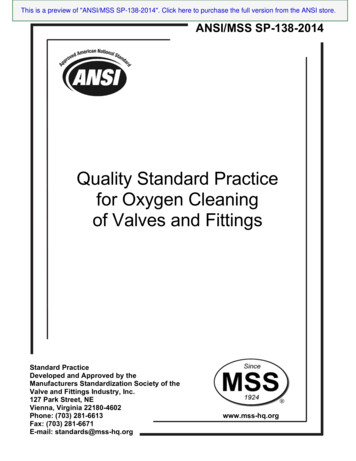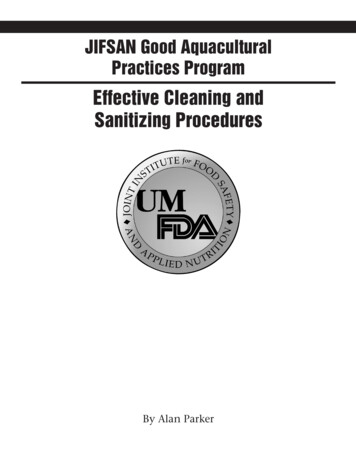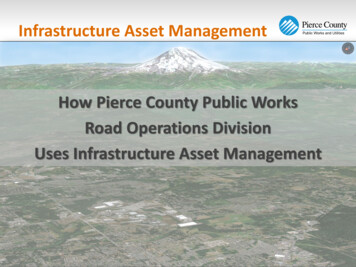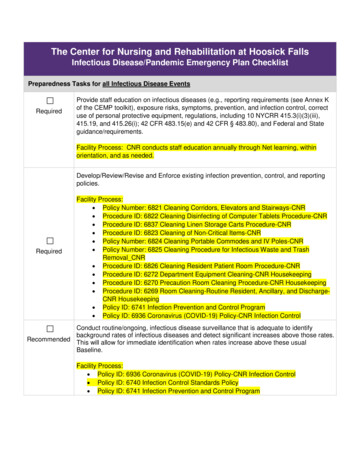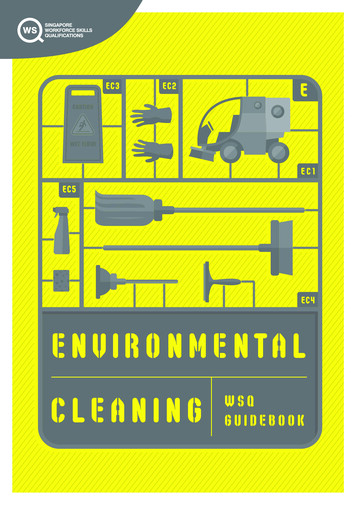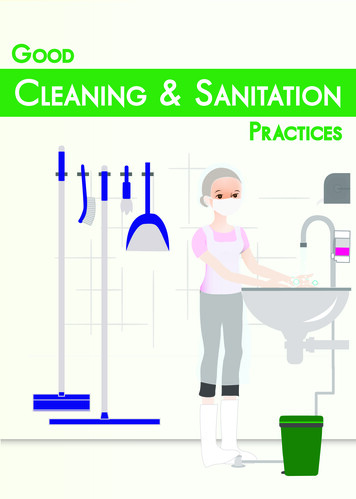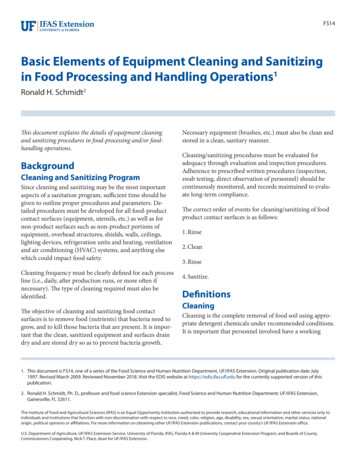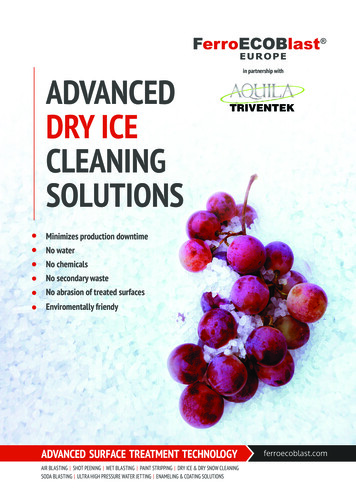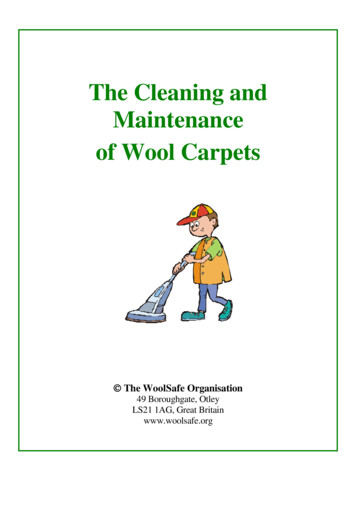
Transcription
The Cleaning andMaintenanceof Wool Carpets The WoolSafe Organisation49 Boroughgate, OtleyLS21 1AG, Great Britainwww.woolsafe.org
IntroductionRegular maintenance and periodic cleaning will increase the life span of a carpetand also greatly contribute to maintaining its good appearance. Cleaning shouldbe proportional to the amount of soiling to which the carpet is subjected - themore dirt is deposited on the carpet, the more intensive the required maintenanceprogramme has to be.To appreciate the reasons why carpets are cleaned in aparticular way, it is essential to know what makes carpetcleaning necessary in the first place - soiling. To understandwhy certain cleaning or maintenance techniques are used incertain locations and on given types of carpet, it is necessaryto know something about the relationship between theavailable cleaning systems and different types of carpet.There is a distinct difference between cleaning and maintenance: cleaning is the removal of accumulated dirt and is generally carried out whenneeded; whilst maintenance is a planned procedure, started on the day the carpet isinstalled and on-going to retain a carpet's good appearance.This booklet is an introduction to the increasingly sophisticated techniques ofcarpet cleaning and maintenance.CONTENTSPageHow Carpets Soil. . . . 3Maintenance Planning . . . . 3Spot Removal Guide. . . . 6Recommended Cleaning Methods for Wool Carpets. 9Cleaning Chemicals. . . . 10Recommended Maintenance Programmes . . 11WoolSafe Approved Service Providers . . 12WoolSafe Registered Inspectors.12Green Cleaning .122
1How Carpets SoilDirt particles carried into a building on the soles of shoes or by air currents aredeposited on the carpet surface and stick to the pile fibres. These dirt particles areheld by mechanical forces in the yarn structure, or by adhering to the fibresurface because they are sticky (oily) themselves, or because the fibre is sticky,damaged, or has other sites where soil can lodge.There are two main types of soil (dirt):Type 1coarse, dry, heavy soil – e.g. sand, fibres, salts etc – which causescarpet "to fill up with dirt", and which is deposited as far down asthe roots of tuftsType 2fine, sticky, lightweight soil – e.g. soot, oil, rust, etc – which causesmost of the discolouration of the carpet surface and makes the carpet"look dirty"These two kinds of dirt have to be removed using different techniques:Type 1by mainly mechanical means – e.g. vacuum (suction) cleaningType 2by mainly chemical means – e.g. shampooing, or impregnatedcompound cleaningThe more carpets soil, the more difficult and often expensive, it becomes to cleanthem. It therefore makes sense to try to reduce the rate at which carpets soil bysomehow trying to reduce the amount of soil reaching the carpet. This can bedone by taking preventative measures such as the installation of adequate lengthsof entrance mats, and by good housekeeping – e.g. by preventing spillages andby putting mats in lifts and in front of drink dispensing machines.2Maintenance PlanningThe importance of proper planning of a maintenance programme for thecarpeting in a building, however large or small, cannot be over-emphasised. Themaintenance plan should take into account foot traffic loads, traffic patterns,desired appearance levels of the carpeting in different areas of the building,building occupation, the personnel responsible for the maintenance, availableequipment and cleaning costs.Correct and regular maintenance will be cost-effective and also increase thelife span of carpeting.3
Carpet maintenance usually consists of three categories: 2.1.routineinterimperiodicPreventive measuresTo minimise the ingress of air-borne soil it is important to maintain a positiveair pressure within a building via air conditioning and the incoming air mustbe filtered. To prevent draught (filtration) marking all edges of rooms beneathskirtings must be sealed.Most dirt is tracked into the building from outside. As preventivemaintenance, entrance mats, also referred to as scraper, walk-off or barriermats, should be placed outside the front and rear entrances. Adequate lengthsof matting inside these entrances ensure that walked-in dirt causes as littledamage as possible to the textile floor covering.Applying a WoolSafe approved carpet protector can prevent excessive soilingof sensitive carpets.2.2.Routine MaintenanceUsually carried out on a daily basis, this comprises vacuum (suction) cleaningof all regularly trafficked areas and spot removal. Extra care must be taken ofthe most heavily used areas, including entrance mats. Areas of minimal use canbe vacuum cleaned at a lower frequency, for instance twice weekly.Spills should be given attention as soon as possible – the older the stain, themore difficult it is to remove.Always at hand and free to download the awardwinning WoolSafe Carpet Stain Cleaning GuideApp is an essential tool for Facilities Managersand cleaning staff to have at their fingertips. Theapp is easy to use with step by step stainremoval instructions, lists of professional andconsumer approved products and contact detailsof Approved Service Providers.Spot removal kits containing all the tools to tackle spills likely to occur must beavailable to maintenance personnel trained in their use and with access to the kitsat all times during carpet maintenance periods.
It is important to check the chemicals in the kits are compatiblewith the carpet installed – applying them must not cause colourbleeding or bleaching, or any other damage to the carpeting.Products that are safe and effective on wool and advancedgeneration nylon fibres are identified by the WoolSafe Mark.Spot removal kits should contain at least the following: clean tissues and/or towelssmall brush, spoon (or spatula) and spongesolvent for removing greasy/oily stainscarpet shampooacetone/nail polish removercarpet shampoochewing gum remover (solvent or freezing type)neutralising agents: acetic acid solution, ammonia solution (5%)methylated spirits and turpentine or white spiritrust remover.Spot removal chemicals must be used with proper precautions. When in use, thearea must be well ventilated, the agents should not come into contact with skin orthe fumes be inhaled. Flammable agents must not be used when the operator issmoking, or near open flames, sparks etc. Proprietary spot removers must carrythe WoolSafe Mark.The recommended spot removal procedure is as follows: Scoop up solids and blot up liquids first - avoid rubbing the carpetsurface. Spots of known origin are treated according to the Spot RemovalGuide, see pages 6 and 7. For spots of unknown origin, apply solvents (for greasy/oily stains) first,followed by water-based spot removal agents. In all cases, apply agent to clean towel or tissue, not directly to the stain.Use small quantities at a time - always work from edge of stain inwardstowards the centre. If at all possible, as a final treatment, rinse spot withclean water - do not over wet blot as dry as possible with clean tissues or towelling.5
Some chemicals are hazardous and they all should only be used strictly inaccordance with their use and safety instructions.EASY SPOTSSpot or stainBloodBurn/scorch marksButterCandle waxChewing gumChocolate/cocoaColaCreamEggFloor waxFruit juiceGravy and saucesHerbal teaMetal polishMustardOil and greasePaint (emulsion)Shoe polishTeaWine1234567891011121314Try 1st513789537573535573733Try 2nd61457Try 3rd375565566666555556Blot with white kitchen roll or paper tissuesVacuum cleanCold waterWarm waterWoolSafe-approved carpet shampoo solution (diluted)WoolSafe-approved spot remover for water-based stainsWoolSafe-approved spot remover for greasy/oily stainsAbsorbent paper or paper tissue and hot iron (on wool carpet only!)Chewing gum remover (solvent or freeze type)Nail varnish remover or acetoneWhite spirit or turpentine substituteSurgical spirit (ethyl alcohol or ethanol)Rub with a coinRub gently with coarse sand paper
DIFFICULT SPOTSSpot or stainArtificially coloured drinksBleachCentral heating radiator fluidCoffeeFelt-tip penFurniture polishGlue/adhesive (plastic base)Ink (fountain)Ink (ballpoint pen)LipstickMilkNail varnishPaint (oil)RustSootTar (asphalt)Urine (fresh stain)Urine (old stain)VomitWine (red and rosé)Try 1st331647 or 1171031274101116673651Try 2nd617Try 3rd612511615525156615WoolSafe-approved disinfectant or deodoriserRust removerCarpet re-colouring kitFor the best results engage the services of WoolSafe ApprovedService Providers, who are specially trained in all aspects forcaring for wool carpets (see also page 12).For your nearest WoolSafe Approved Service Provider, checkout our online directory on www.woolsafe.org or contact theWoolSafe Organisation (01943 850 817; office@woolsafe.org).755Treatments used by professional carpet cleaners151617515
2.3Interim Cleaning*Used to brighten the appearance of the carpeting by removing surface dirt.This procedure does not necessarily remove much of the deep-seated soil inthe pile.Interim cleaning is a fast and relatively low cost method of restoring theappearance of wool floor coverings. Actual soil removal is generally restrictedto the use-surface only. This technique is extremely useful in high traffic areassuch as lifts and traffic lanes. Correctly done, the wool floor covering can bedry within an hour.Six basic systems can be used:spray mist rotary pad (bonnet cleaning) method;thermo-pad system;absorbent compound cleaning method;dry foam cleaning method — cylindrical-brush shampoo machines;crystallising or encapsulating shampoo cleaning method.Prior to any of the following cleaning methods a thorough suction cleaning isan essential part of the overall process. After cleaning is completed and thefloor covering has dried it must be suction cleaned to remove any residues ofdirt and cleaning agent.2.4Periodic Cleaning*However meticulously both regular maintenance and interim cleaning arecarried out, the time might come when the carpeting will require a thorough,deep or restorative cleaning. Systems used are based on shampooing using ahigh foam carpet shampoo or spray extraction cleaning, using a low foamdetergent.Before wet cleaning, the carpet pile is usually treated with a pile lifter, a twinmotor vacuum cleaner with a large cylindrical brush and powerful suctionaction. This opens up the pile and removes embedded grit normally left behindby vacuuming.* In the maintenance programme of some absorbent compoundsystems interim and periodic cleaning are essentially combined. By thecorrect and thorough use of these systems the use of wet cleaning can beavoided all together.8
Shampooing involves the use of a rotary or cylindrical brush machine whichbrushes a shampoo solution ("wet" shampoo) or a shampoo foam ("dry"shampoo) into the carpet pile. After this is completed, the dirt-laden shampoois either sucked out of the pile by means of a wet pick-up machinerinsed out using a spray extraction machine (charged with water only)Spray extraction cleaning injects a detergent solution into the carpet pile,immediately followed by an integral wet pick-up system. The amount ofsolution sprayed into or onto the carpet pile varies greatly between machinemodels and makes and speed of each pass of the wand. This affects both theefficiency of the "flushing" out of the dirt and the chance of inadvertentlyover-wetting the carpet.Cleaning efficiency can be improved by pre-spraying the carpet with the lowfoam shampoo 10 minutes prior to spray extraction, and by the use of rotatingor oscillating brushes in the floor "wand" of the machine.With all wet cleaning techniques, it is important to avoid over-wetting thecarpet as this will greatly lengthen the drying time and may cause problemswith discolouration of the pile. Brushing of the pile should also be kept to aminimum, especially with some carpet constructions. It is stronglyrecommended that the carpet be pre-tested before starting any wet cleaning toensure neither the chemicals (shampoos or spot removal products) nor theactual cleaning technique cause damage to the structure or colour of thecarpet. On wool (rich) carpeting, only WoolSafe approved chemicals should beused.3Recommended Cleaning Methods for Wool CarpetsThere are no hard and fast rules on which cleaning technique is the best forwool carpets. It depends largely on the type of carpet concerned and thedegree and type of soiling.As a general rule, cleaning methods involving brushes or beaters should beavoided on long pile or coarser loop pile wool carpets. In these cases, plainsuction vacuum and spray extraction wet cleaning are often the best methods.It will also depend on the skill of the operator - no technique is completelyfoolproof.9
The damage to carpets in (wet) cleaning usually relates to over-wetting, toomuch mechanical action and the use of unsuitable chemicals. Wet cleaning hasboth positive and negative effects on the texture of carpets. The positiveeffects are: lifting of the carpet pileimprovement in tuft definition (especially on loop pile)improved handleimproved colour and design (if appropriate)improved hygiene, reduced allergensAll wet processes cause some untwisting of yarn in cut pile carpets, dependingon amount of moisture applied, mechanical action, degree of "setting" of theyarn, etc. Brushing causes some fuzzing (in shampooing, but also with uprightvacuum cleaners). Ridging on extremely long pile carpets can be caused bysome spray extraction cleaning tools.4Cleaning ChemicalsThe basic requirements of cleaning chemicals for use on wool are: low alkalinity, non-sticky residue on drying, good cleaning power, no added bleaches, dyes etc. safe in use and safe once applied to the carpet.The reasons for these requirements are: high alkalinity (often, but by no means always, reflected in high pH) cancause colour bleeding with dyed yarns, pigment bleeding in naturalberbers, jute staining of pile surface in light coloured carpets, and – inextreme cases – yellowing and weakening of wool fibres;sticky residues cause quicker re-soiling;poor cleaning performance necessitates excessive mechanical agitation ofthe pile and added risk of pile distortion;additives can cause uneven cleaning, bleaching or change of colour.Some commercially available carpet cleaning chemicals do not conform toone or more of the above requirements. To identify those that are safe to use,an approval programme for wool carpet maintenance products was establishedin 1991, called WoolSafe.10
All products tested and approved under this programme carry one of theWoolSafe Marks on packaging and/or product literature. Some examples ofthe Mark are:5Recommended Maintenance ProgrammesWhen writing maintenance programmes for carpets in contract locationsa number of aspects must be considered. The level of maintenancerequired for a given location within a building – frequency, intensity,equipment used, etc. – depends on the severity of the traffic and the typeof soiling that occurs. Most buildings can be divided into four categories:light, medium, heavy and extra heavy soiling. These in turn will requirecorresponding levels of maintenance. Suggested maintenanceprogrammes for the different soiling categories are given in the Tablebelow.SoilinglevelMaintenanceRoutine umDailyDailyEvery 23 days12months6-12monthsHeavyIntenseDailyDailyDaily3 Light11
More detailed information about carpet cleaning techniques, equipment andplanning can be found in the WoolSafe Standards WS 1000, “TheMaintenance and cleaning of wool floor coverings” and WS 2000, “Code ofPractice for Professional Carpet Cleaning Companies”. Both are availablefrom The WoolSafe Organisation.6WoolSafe-accredited carpet cleaning companiesThe WoolSafe Organisation operates an accreditation schemefor professional carpet cleaners, called the WoolSafe ServiceProviders programme. WoolSafe Service Providers are fullytrained in all carpet cleaning techniques, have been in businesscontinuously for a period of at least 5 years and haveappropriate insurance cover. They have attended the WoolSafetraining course, have passed a written exam and meet other requirementsrelating to their business and professional associations. WoolSafe ApprovedService Providers use WoolSafe-approved products whenever they clean woolcarpets or rugs.7If you have a problem with your carpet or rug that requires an independent inspector, a network of carpet complaintinvestigators, trained and registered by the WoolSafeOrganisation is available throughout the UK and Ireland. Tocontact a WoolSafe Registered Inspector in your area call01943 850817 or visit www.woolsafe.org and click “A CarpetInspector” in the shortcut menu on the left hand side of the homepage.8Green CleaningIn April 2007 The WoolSafe Organisation launched a ‘green’version of the WoolSafe Mark. This Green WoolSafe Markemphasises the fact that the product is not only safe andeffective to use on wool carpets and rugs, but is alsosignificantly less damaging to the environment through itsmanufacture, use and disposal.12
cleaning is the removal of accumulated dirt and is generally carried out when needed; whilst maintenance is a planned procedure, started on the day the carpet is installed and on-going to retain a carpet's good appearance. This booklet is an introduction to the increasingly sophisticated techniques of carpet cleaning and maintenance.


